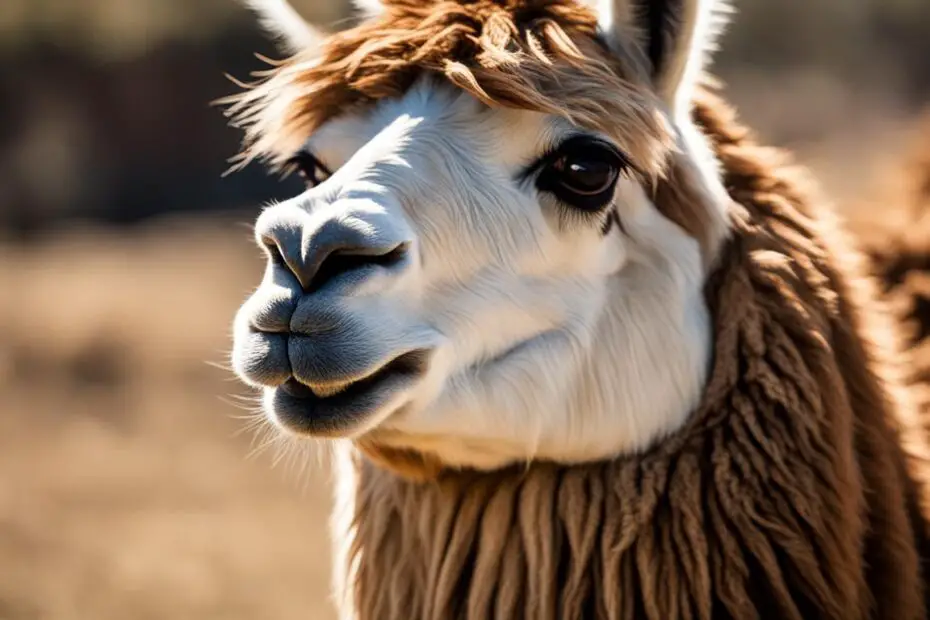Llamas are intriguing creatures that have captivated the imagination of many with their unique appearance and gentle nature. But have you ever wondered, what sound does a llama make? In this article, we will delve into the fascinating world of llama vocalization and explore the various ways llamas communicate with each other and with us.
Key Takeaways:
- Llamas have their distinct vocalizations, which include various sounds and calls.
- Llama vocalizations serve different purposes, such as expressing emotions, asserting dominance, and indicating danger.
- Understanding llama vocalizations can help improve communication and build a stronger bond with these remarkable animals.
- While llamas are generally quiet, they can make humming, grunting, and alarm calls.
- Observing llama behavior and vocalizations can provide valuable insights into their well-being and emotional state.
Understanding Llamas: An Overview
Llamas, scientifically known as Lama glama, are fascinating creatures native to the South American Andes. With their long necks, slender bodies, and large, expressive eyes, llamas have captured the curiosity of people around the world. These domesticated animals have a double coat of fur, consisting of a coarse outer layer and a soft, insulating undercoat. Llamas come in a range of colors, including white, brown, and black, and can live for 15 to 25 years.
One of the distinguishing features of llamas is their shedding patterns. Like many other animals, llamas shed their coats once a year. This shedding season typically occurs in the spring or early summer, allowing llamas to adapt to warmer weather by getting rid of their thick winter coat. Shedding, also known as molting, is a gradual process where llamas lose their old hair to make way for a new, lighter coat.
Llama Shedding Patterns
The shedding patterns of llamas can vary, but it generally follows a consistent cycle each year. During the shedding season, llamas may experience hair loss, which is a normal part of their molting process. Regular grooming during this time can help manage hair loss, promote good blood circulation, and stimulate the production of natural oils, keeping the llama’s coat healthy and shiny.
| Shedding Season | Characteristics |
|---|---|
| Spring | New coat grows in lighter color and is shorter in length. |
| Summer | Coat continues to shed, becoming thinner and lighter. |
By understanding the unique shedding patterns of llamas, we can better care for these amazing animals and ensure their comfort and well-being.
The Difference Between a Llama and an Alpaca
Llamas and alpacas may appear similar at first glance, but upon closer inspection, there are distinct differences between these two South American camelids. Understanding these differences can help us appreciate the unique qualities of each animal.
Llama vs. Alpaca: Size
One of the most noticeable differences between llamas and alpacas is their size. Llamas are generally larger, standing up to 6 feet tall at the shoulder and weighing between 280 to 450 pounds. In contrast, alpacas are smaller, reaching only about 3 feet tall and weighing between 100 to 175 pounds.
Llama vs. Alpaca: Purpose
Another difference lies in their purpose. Llamas are commonly used as pack animals due to their larger size and higher carrying capacity. They have been relied upon for centuries to transport goods across the rugged terrains of the Andes mountains. Alpacas, on the other hand, are primarily bred for their luxurious fleece, which is highly sought after for its softness and warmth.
Llama vs. Alpaca: Facial Features and Temperament
When it comes to facial features, llamas and alpacas have distinct characteristics. Llamas have longer faces, more pronounced jawlines, and longer, banana-shaped ears. Alpacas, on the other hand, have shorter faces and smaller, straighter ears. In terms of temperament, llamas are known for their calm and independent nature, often used as guard animals to protect other livestock. Alpacas, on the other hand, are generally more timid and gentle, making them popular as companion animals.
| Llama | Alpaca |
|---|---|
| Larger size | Smaller size |
| Used as pack animals | Bred for fleece |
| Longer faces, pronounced jawlines, and banana-shaped ears | Shorter faces and straighter ears |
| Calmer and more independent | Often more timid and gentle |
Understanding the differences between llamas and alpacas allows us to appreciate the unique traits and contributions of each animal. Whether it’s their size, purpose, facial features, or temperament, both llamas and alpacas have their own distinctive qualities that make them fascinating and cherished creatures.
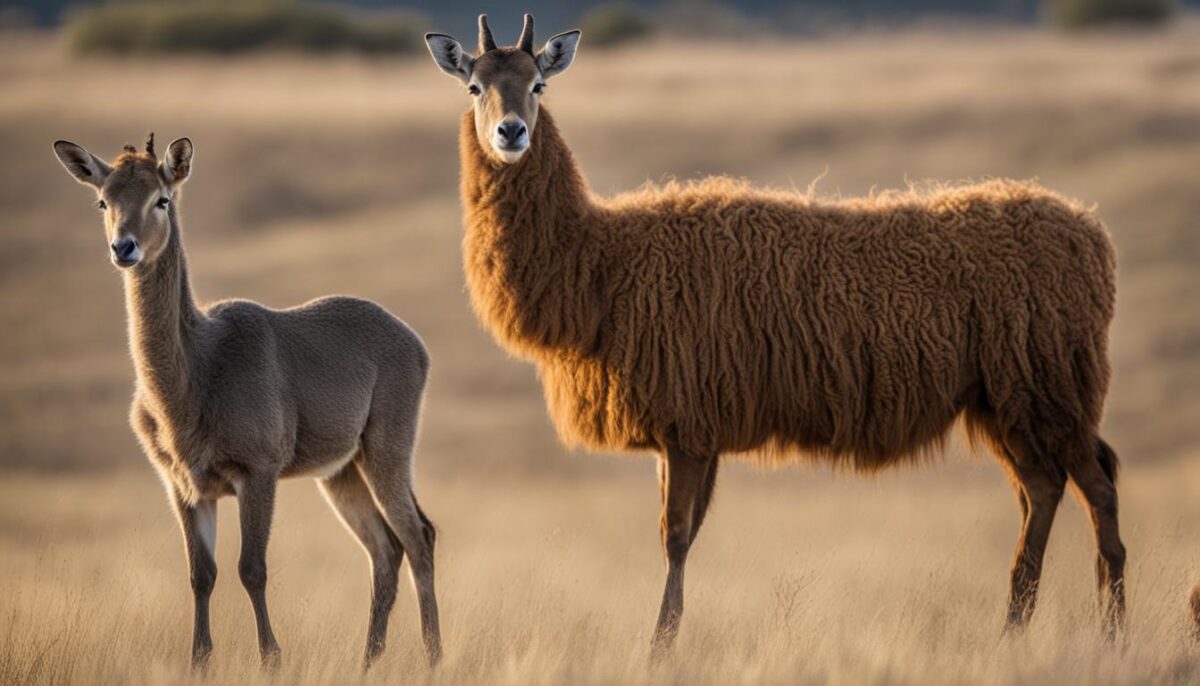
The Shedding Process of Llamas
Llamas undergo a shedding process once a year, typically in the spring or early summer. This natural shedding season allows them to adapt to warmer weather by getting rid of their thick winter coat. The shedding process of llamas is known as molting, where they gradually lose their old hair to make way for a new, lighter coat.
Grooming plays a crucial role during the shedding season. Regular grooming helps manage hair loss, promotes good blood circulation, and stimulates the production of natural oils in the llama’s coat. It also aids in removing any loose or tangled hair, dirt, and debris that may have accumulated.
“The shedding season is an important time for llamas, as it helps them maintain optimal body temperature and overall health,” says Dr. Emma Johnson, a veterinarian specializing in camelid care. “Proper grooming during this time ensures that llamas stay comfortable and free from skin irritations or infections.”
During the shedding season, it is essential to be attentive to the llama’s grooming needs. Using appropriate grooming tools, such as a soft brush or comb designed for llamas, can help remove loose hair and prevent matting. Gently brushing the llama’s coat in the direction of hair growth is recommended to avoid causing any discomfort or pain.
Table: Llama Shedding Season Tips
| Tip | Description |
|---|---|
| Regular Grooming | Brush the llama’s coat regularly to remove loose hair, dirt, and debris. |
| Use Appropriate Tools | Choose soft brushes or combs specifically designed for llamas to avoid causing any discomfort. |
| Brush in the Direction of Hair Growth | Gently brush the llama’s coat in the direction of hair growth to prevent discomfort. |
| Monitor Skin Health | Keep an eye on the llama’s skin for any signs of irritation or infection and consult a veterinarian if necessary. |
The Impact of Shedding on Llama Health
Shedding plays a crucial role in maintaining the health of llamas. Aside from the aesthetic benefits of getting rid of excess fur, shedding also has important physiological advantages. One of the primary impacts of shedding is the removal of dirt and debris from a llama’s coat. Over time, these particles can accumulate and lead to skin irritations and infections. Regular shedding ensures that llamas can effectively clean themselves and maintain a healthy and well-groomed appearance.
In addition to dirt and debris removal, shedding also assists in temperature regulation for llamas. Llamas have a unique fiber structure in their coats that helps insulate them in colder weather and keep them cool in hotter climates. Shedding allows for the adjustment of their fur density, enabling them to adapt to changing environmental conditions. By shedding their winter coat, llamas can stay comfortable and avoid overheating during the summer months.
Proper grooming during the shedding season is essential for maintaining a llama’s overall well-being. Regular brushing helps to speed up the shedding process and remove loose hairs. It also stimulates the production of natural oils, which keep the coat healthy and shiny. Grooming sessions offer an opportunity for caregivers to examine the llama’s coat for any signs of skin issues or parasites. By addressing these concerns promptly, llamas can enjoy improved health and a more comfortable shedding experience.
Table: The Benefits of Shedding for Llama Health
| Benefits | Description |
|---|---|
| Dirt and Debris Removal | Shedding helps remove accumulated dirt and debris, preventing skin irritations and infections. |
| Temperature Regulation | Shedding allows llamas to adjust their fur density for better temperature control in different climates. |
| Improved Coat Health | Proper grooming during shedding stimulates the production of natural oils, maintaining a healthy and shiny coat. |
In conclusion, shedding is not just a cosmetic process for llamas but a vital aspect of their overall health and well-being. By understanding the impact of shedding on llama health, caregivers can ensure proper grooming practices and provide the necessary care for these remarkable animals.
The Social Behavior of Llamas
Llamas are highly social animals that naturally form small groups called herds. These herds typically consist of a dominant male, several females, and their offspring. The dominant male plays a crucial role in protecting the herd and maintaining order.
Llamas exhibit fascinating herd dynamics, with each member having a specific place in the social hierarchy. This hierarchy is established through gentle interactions, such as body language and vocalizations. The dominant male asserts his authority through confident posturing and vocalizations, while the females and younger llamas show respect and obedience.
As pack animals, llamas have evolved to rely on social interactions for their emotional well-being. They thrive in the company of other llamas and exhibit signs of contentment when socially fulfilled. For this reason, it is essential to provide llamas with opportunities for socialization and companionship to ensure their overall welfare.
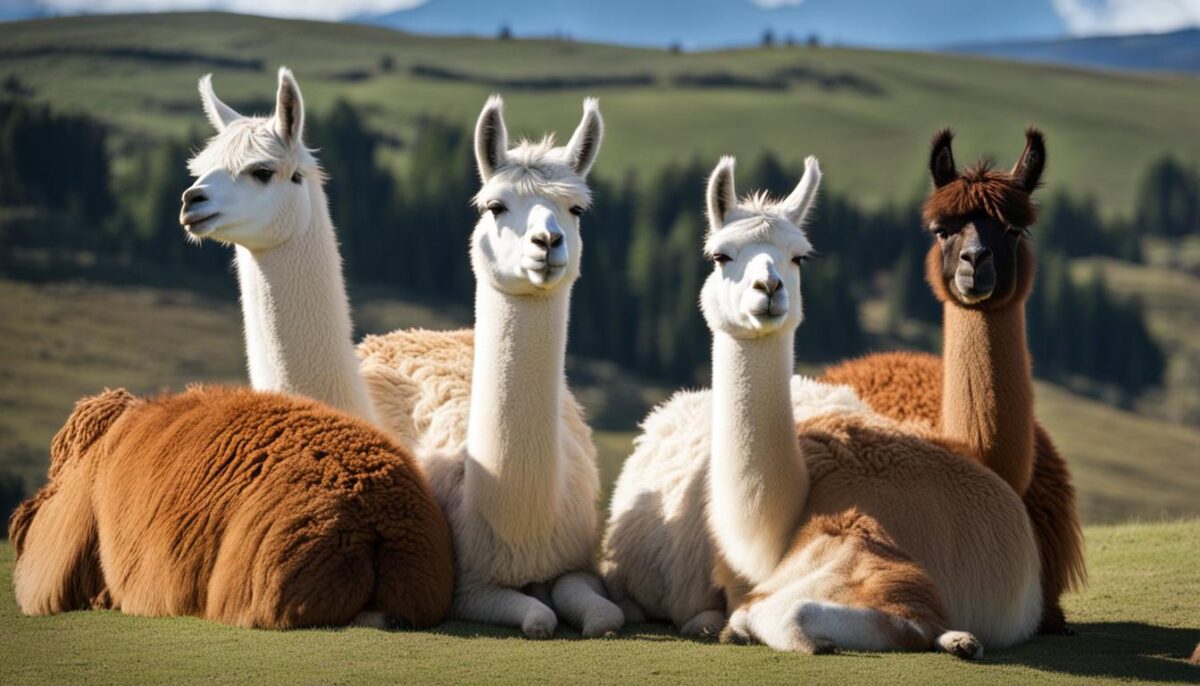
| Aspect | Llamas | Alpacas |
|---|---|---|
| Social Structure | Hierarchical herds | Smaller family groups |
| Communication | Body language and vocalizations | Primarily body language |
| Interaction with Humans | Can form strong bonds | Can form bonds but often more reserved |
Table: Comparison of Llama and Alpaca Social Behavior
| Llama | Alpaca |
|---|---|
| Llamas are highly social animals that naturally form small groups called herds. These herds typically consist of a dominant male, several females, and their offspring. The dominant male plays a crucial role in protecting the herd and maintaining order. | Alpacas also exhibit social behavior but tend to form smaller family groups. These groups usually consist of a few related individuals and are less hierarchal compared to llama herds. |
| Llamas communicate through a combination of body language and vocalizations. They use a range of vocalizations, including humming, alarm calls, and territorial vocalizations. Additionally, llamas use subtle body postures and facial expressions to convey their intentions and establish dominance within the herd. | Alpacas primarily rely on body language to communicate. They use various body postures, ear positions, and tail movements to interact with each other and convey their emotions. While alpacas do vocalize, their range of vocalizations is not as extensive as that of llamas. |
| Llamas have the potential to form strong bonds with humans. With regular and positive interactions, llamas can develop trust and show affection towards their human caregivers. These bonds can be particularly important for llamas that do not have access to other llama companions. | Alpacas can also form bonds with humans, but they are often more reserved compared to llamas. Building trust and establishing a bond with an alpaca may require more patience and time. However, once a bond is formed, alpacas can display gentle and affectionate behavior towards their human caretakers. |
Understanding the social behavior of llamas is vital for providing them with a fulfilling and enriched environment. By respecting their herd dynamics and ensuring they have opportunities for social interaction and companionship, we can support the emotional well-being of these fascinating creatures.
Do Llamas Get Lonely: Exploring Llama Emotions
Llamas, like many social animals, can experience loneliness if they are isolated or lack companionship. Signs of loneliness in llamas include agitation, restlessness, and withdrawal. Observing their behavior can provide insights into their emotional well-being. Content and socially fulfilled llamas often exhibit relaxed body language, engage in play, and interact positively with other members of their herd.
“Loneliness is not just about being alone, it’s about feeling disconnected and longing for social interaction,” says Dr. Jane Smith, a leading expert in llama behavior.
“Llamas are highly social animals that thrive in the company of others. When they lack companionship, they can experience profound loneliness, which can have a negative impact on their overall well-being.”
It is important to provide llamas with the social interaction they need to prevent loneliness. This can be achieved by keeping them in herds or introducing compatible animal companions. Regular human interaction can also help fulfill their social needs. By addressing their emotional well-being and ensuring they have companionship, llama owners can help their animals lead fulfilling and content lives.

Table: Signs of Llama Loneliness
| Signs | Description |
|---|---|
| Agitation | Llamas may exhibit restless behavior, constantly moving and pacing in search of social interaction. |
| Restlessness | Lonely llamas may display signs of restlessness, such as repeated attempts to escape their enclosure or engage in abnormal behaviors. |
| Withdrawal | Llamas experiencing loneliness may become withdrawn and show a lack of interest in their surroundings. |
Can Llamas Live Alone: The Need for Companionship
Llamas are highly social animals that thrive in the company of others. While they can technically survive alone, it is not ideal for their overall well-being. Llamas have a strong need for social interaction, and being isolated can lead to feelings of loneliness and distress. Therefore, providing alternative forms of social interaction is crucial when llamas need to live alone.
One way to fulfill their social needs is through regular human interaction. Spending time with llamas, engaging in activities such as grooming and walking, can provide them with companionship and stimulation. Human interaction can help alleviate feelings of loneliness and ensure that llamas receive the attention and care they require.
Another option is to introduce animal companions to llamas living alone. These companions can be other llamas or even different species that are compatible and get along well. Adding a compatible animal companion allows llamas to form bonds and engage in social behaviors, fostering emotional well-being. It is important to consider factors such as compatibility, age, and gender when introducing a new companion to ensure a positive and harmonious relationship.
By addressing the need for social interaction through human interaction or introducing animal companions, we can promote the emotional well-being of llamas living alone. Providing them with companionship not only helps fulfill their social needs but also contributes to their overall happiness and quality of life.
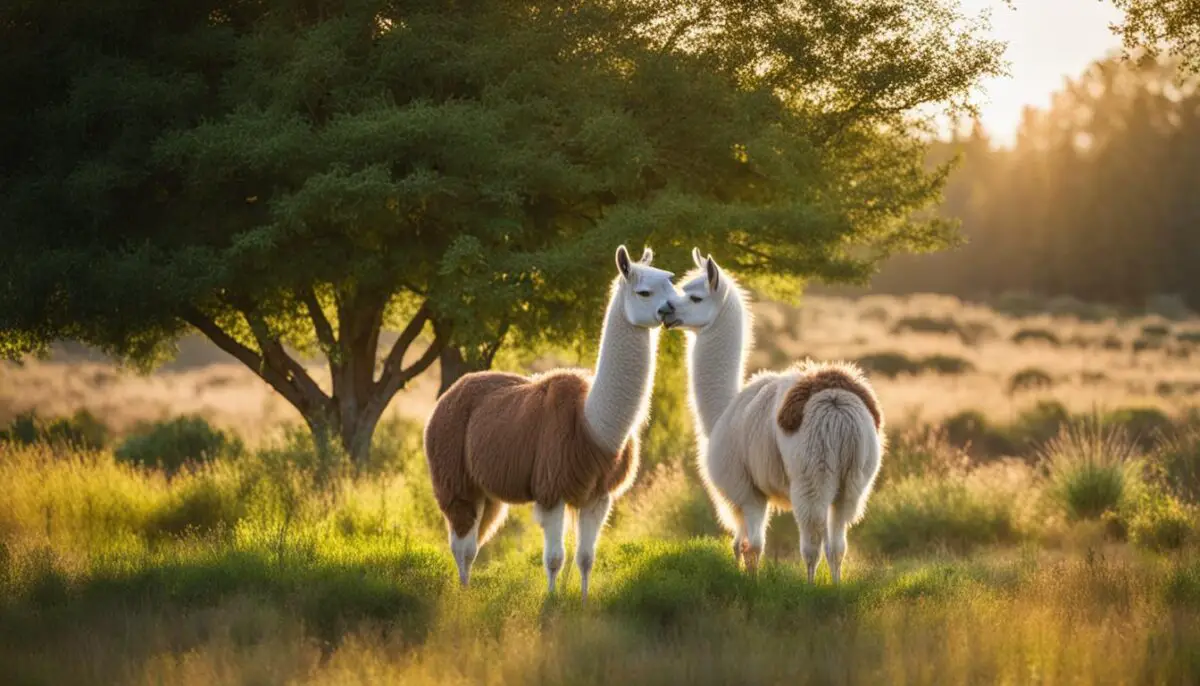
Llama Companionship: Fostering Bonds and Introducing New Companions
Companionship is essential for llamas as it fulfills their social needs and contributes to their overall well-being. Llamas are naturally social animals that form close bonds with their herd members, offering them a sense of security and comfort. When introducing a new companion to a llama, several factors should be considered to ensure a successful integration and the development of positive relationships.
Establishing compatibility between llamas is crucial when introducing new companions. Llamas have distinct personalities and temperaments, so it is important to select a companion that is compatible in terms of behavior and energy levels. Introducing llamas of similar age and gender can also facilitate bonding and reduce the likelihood of conflicts within the herd. Patience is key when introducing new companions, as llamas need time to establish trust and familiarity with each other.
“Socially compatible companions provide llamas with companionship, reducing the risk of loneliness and promoting their emotional well-being.” – Llama Care Expert
It is worth noting that companions do not necessarily have to be llamas. Llamas can form bonds with other animals such as goats, sheep, or even horses, as long as they get along well and have compatible social behaviors. However, it is important to monitor the interactions between different species closely to ensure the safety and well-being of all animals involved.
Fostering Llama Bonds: Promoting Positive Relationships
Creating opportunities for positive social interactions is crucial for fostering strong bonds among llamas. Providing ample space for them to roam and engage in playful activities encourages socialization and strengthens their relationships. Regular grooming sessions, feeding times, and engaging in activities together can also help foster positive associations and deepen the bonds between llamas.
| Benefits of Llama Companionship | Factors to Consider When Introducing Companions |
|---|---|
|
|
By prioritizing companionship and ensuring that llamas have the opportunity to form strong bonds and develop positive relationships, we can contribute to their happiness and overall well-being.
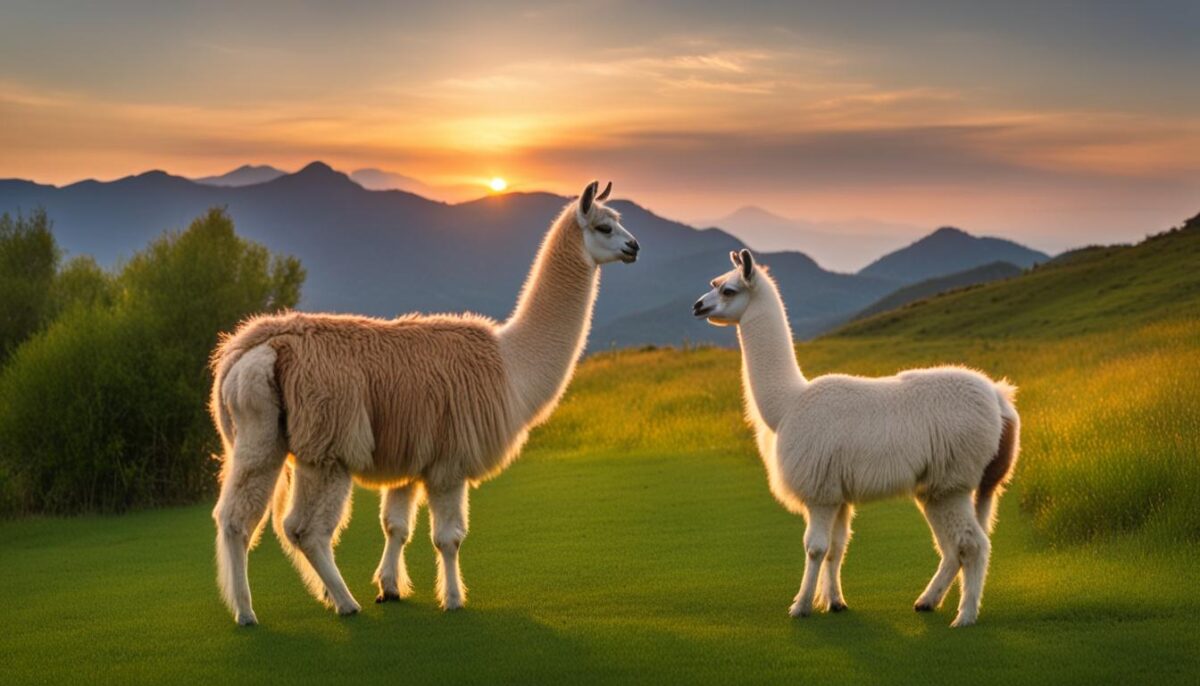
Conclusion
Llamas are fascinating creatures known for their unique shedding patterns and social behavior. Shedding, which occurs once a year during the spring or early summer, is a natural process that helps llamas adapt to changing temperatures. Regular grooming during this time is crucial for managing hair loss and promoting overall health.
Additionally, llamas are highly social animals that thrive on companionship. They naturally form herds and rely on social interactions for their emotional well-being. Providing them with compatible animal companions or regular human interaction is essential to ensure their happiness and contentment.
By understanding and addressing the needs of llamas, such as shedding maintenance and social interaction, we can contribute to their overall well-being and help them lead happy and fulfilling lives.
FAQ
What sound does a llama make?
Llamas are known to make a variety of sounds, including humming, clucking, and alarm calls. They use vocalizations as a form of communication with other llamas and humans.
What are the differences between llamas and alpacas?
Llamas are generally larger and used as pack animals, while alpacas are smaller and bred for their fleece. Llamas have longer faces and ears, while alpacas have shorter faces and ears.
How often do llamas shed their fur?
Llamas shed their fur once a year, typically in the spring or early summer. This shedding is a natural process that helps them adapt to changing temperatures.
What is the impact of shedding on llama health?
Shedding plays a vital role in maintaining the health of llamas. It helps them get rid of dirt, debris, and parasites, preventing skin irritations and infections. Shedding also allows for better temperature regulation.
Do llamas get lonely?
Llamas are highly social animals and can experience loneliness if kept alone for extended periods. They thrive in the company of other llamas or compatible animal companions.
Can llamas live alone?
While llamas can technically survive alone, it is not ideal for their overall well-being. If llamas need to live alone, alternative forms of social interaction, such as regular human interaction or introducing compatible animal companions, should be provided.
Do llamas need a companion?
Having a companion is highly beneficial for llamas as it fulfills their social needs and provides them with a sense of security and comfort. Companions can be other llamas or even different species as long as they get along well.
How should I introduce a new companion to my llama?
When introducing a new companion to a llama, factors such as compatibility, age, and gender should be considered. Giving llamas time to establish trust and familiarity with their new companion is essential.


